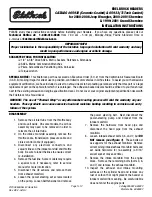
14
3. Instructions for safe operation
3.2 Seat belt
3.2.1 Why must you fasten the
seat belt
Protection of the driver and passengers by
seat belts
In the event of a vehicle collision, the seat belt,
if fastened correctly, can restrain the driver and
passengers in a proper position and slow down
the inertia of their forward movement, thus
preventing them from being thrown forward,
and at the same time allow airbags to give
them the best protection, thus reducing their
impact injury as much as possible.
In the event of a collision, the seat belt will
assist other safety systems in simultaneously
absorbing the energy generated by the
collision, further reducing the injuries suffered
by the driver and passengers.
WARNING
Airbags cannot replace seat belts.
Regardless of the availability of airbags,
the seat belts should be fastened
correctly.
Consequences of not fastening the seat
belt
In the event of a collision, the driver or passenger
who does not fasten the seat belt will be thrown
forward due to inertia and thereby injured.
Even if the vehicle speed is very low, the force
acting on the human body in the event of a
collision is so great that the occupant cannot
control his or her body with hands at all. In that
case, the occupant who does not fasten the
seat belt will be thrown forward, and injured if
colliding with any interior objects.















































